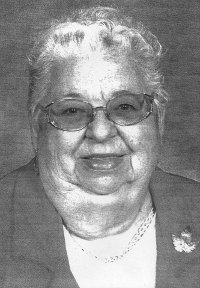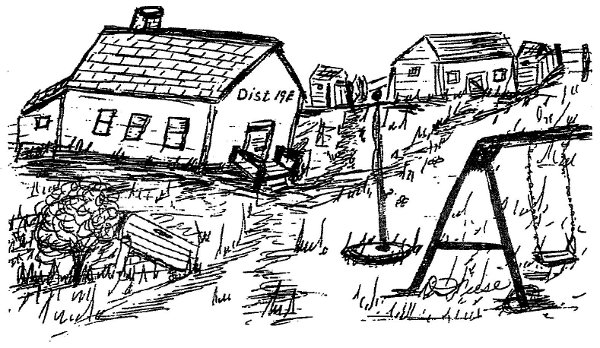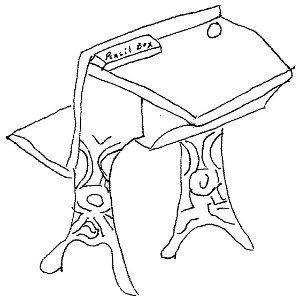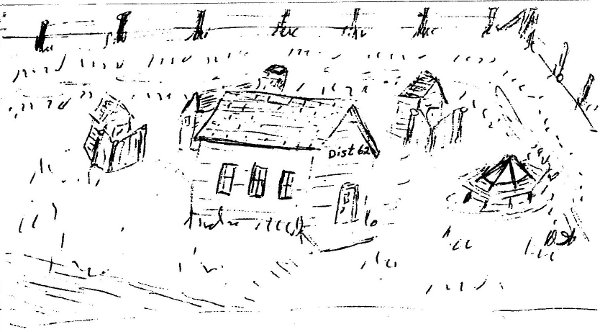Introduction

“It’s a girl! It’s a girl! Fred and Gesine had their baby, and it’s a girl!” That was the talk of the neighborhood near McLean, Nebraska on May 1, 1925. Born on May Day, Deloris May was affectionately referred to as the Schlake’s “May basket.”
What was life before plastic, bubble gum, ballpoint pens, and spiral notebooks? Deloris knows! She also knows the excitement felt by children and adults when these things were invented and finally arrived in Northeast Nebraska.
Deloris grew up with hardships, too. She knows what it is like to live during a depression and a world war (WWII). She knows how it feels to become a widow at an early age.
After nearly eighty years of life, Deloris has enough stories to fill a book. This paper is only the “tip of the iceberg,” as the saying goes.
Birth
Deloris was born on her parents’ farm since babies were delivered at home back then. A neighbor lady usually came over to care for the mother until the doctor arrived. If there were older children at home, they generally went to stay with neighbors or grandparents until after the blessed event. Following the baby’s birth, the mother stayed in bed for ten days. Meanwhile, a housekeeper cared for the mother and baby and did the cooking and cleaning until the mother was strong enough to do it herself. The neighbor who helped with Deloris’ birth and care was Mrs. Reed, who the Schlakes referred to as “Grandma Reed” from that day on.
Toys & Entertainment
Childhood toys were limited, but what children had, they truly enjoyed. Many toys were homemade. Deloris always loved dolls, and she received one every year for Christmas. She had a tin doll buggy and a wooden bed that her folks made for her one year for Christmas. When it was turned over, the bed became a cradle. Deloris learned to sew by making clothes for her dolls.
The Reed family customarily invited the Schlakes to their home for Christmas supper. One year Deloris and the Reeds’ granddaughters each received a new, big doll. Dolls weren’t made of rubber or plastic back then – plastic wasn’t even invented yet. They were made of fine, sawdust-like material glued together and pressed into a mold. The dolls were also hollow, which made them quite fragile. Rough treatment would soon break them. “Grandma Reed” said the girl who had the nicest doll next year would be given a whole new outfit for her doll. The one rule was that the dolls couldn’t just sit on a shelf all year. The girls had to play with them and love them. Deloris was the lucky one. The other dolls all had broken arms and legs or cracked heads by the following Christmas, but hers was still intact even after she was married. Deloris was so surprised that Christmas when she received several doll clothes and a closed to go with them, too! “Grandpa Reed” had painted a wooden prune box and strung a wire across one end. He even made little wire hangers for all of the dresses and a coat. “Grandma Reed” had made a coat trimmed in real fur with a hat to match, two cotton dresses for everyday, a silk dress, a long formal dress, and pajamas. She also made socks, slips, and underpants. Every stitch was sown by hand because “Grandma Reed” either couldn’t or didn’t like to sew by machine.
Deloris’ brother, Marvin, received toys such as cars, wagons, marbles, and checkers as gifts during his childhood. One year he was given a wind-up train and a blue care that had real headlights run by batter, which was probably one of the first battery operated cars made. Deloris and her brother always played together, so she enjoyed these toys as well.
The Schlake home didn’t have electricity while Deloris was growing up, and TV wasn’t invented yet. She and her brother read books or played cards, checkers, or dominoes in the evenings. Sometimes the family listened to the radio, which ran on a large battery similar to a car battery. That was expensive, sow it was sensible to play the radio in moderation. In the evenings, Deloris’ “papa” especially enjoyed Amos & Andy, Al Jolson, The Thin Man, Inner Sanctum Mystery, George Burns & Gracie Allen, the news, the weather, and the market reports. During the daytime, her “mama” liked Ma Perkins, My Gal Sunday, and Helen Trent. These shows were the soap operas of that time. After school, Deloris and Marvin were allowed to listen to Little Orphan Annie and Sky King.
The Schlakes also had a phonograph that had to be wound up to play. When the record started to slow down, the music sounded funny! The records broke easily if they were dropped, so they had to be handled carefully.
Electricity was available in town since each town had its own power plant. This made movies possible, and they were a popular attraction. Deloris recalls the cost of tickets to be about twenty-five cents for adults and eleven cents for children under twelve years of age. Some movie stars the Schlake family enjoyed were Will Rogers, Joe E. Brown, Jane Withers, and Laural & Hardy. Deloris like Shirley Temple as well.
In the summertime, outdoor games included hop-scotch and marbles. In the autumn, Deloris and Marvin found big sticks to use as bats to play ball with hard, little green apples that were not edible. If the apple was hit, they ran to their base and back (there were only two of them playing). If they hit it often enough or hard enough, the apple would splatter all over. That was an automatic home run.
Deloris and Marvin entertained themselves in other ways, also. During the depression when there was a shortage of feed for livestock, the children had to herd the cows along the fence between two fields. Deloris and her brother filled their time by whittling on corn stalks to make airplanes and braiding necklaces from dandelions, green foxtail, and other weeds.
When they weren’t herding cows, Deloris and Marvin worked on their playhouse in the grove. They had a high-class playhouse with old twine tied to trees to mark off each room. They swept out the loose dirt and leaves so the floors would be hard dirt. In the “kitchen” were cupboards and furniture made from wooden peach boxes and orange crates. The most exciting part was that the Schlake children were the only ones in the neighborhood with “electric lights.” Deloris and her brother had taken big tubes from an old radio and tied them to tree branches. A long string was tied to each tube so the children could also “turn on the lights.”
Clothing
Girls certainly did not wear jeans or even slacks. They wore dresses with full skirts which hung below their knees. On Mondays, Deloris wore a clean dress and a cotton smock to keep the top of the dress clean. On Wednesdays, she wore another clean smock over the same dress, and on Fridays, she could wear her dress without a smock.
When the weather was cold, girls also wore “long johns” underwear along with long black or dark brown stockings for everyday. The stockings were held up by a garter and pinned to an undershirt or the “long johns.” Girls also wore “leggings” which had to be fastened with a long row of buttons. On Sundays, Deloris could wear lighter brown stockings with rayon thread blended with the cotton to give them a shiny look.
Grade School

Children who lived in the country attended school in small, country schoolhouses. All eight grades were taught by one teacher in one room in these schools. Many country schools didn’t have kindergarten at that time.
The teacher typically boarded at a home in the district, usually one that didn’t have children in school to avoid “teacher’s pet” accusations. The home might be located conveniently close to the schoolhouse, or it might be a mile away. Teachers generally walked to school the same as most children did.
Deloris and Marvin walked nearly a mile to their school, District 19 East. If there had been a snowstorm, school would still be held. The teacher and children would just have to walk over the drifts.
Inside the school building was a shelf for dinner pails and a hallway full of hooks for coats and caps. On the wall in the classroom hung a big clock and pictures of George Washington and Abraham Lincoln.
Most schools had a crock water fountain. Water was carried to school in a bucket by a family who lived nearby. Every family brought a cup and a hand towel on Mondays and took them home again on Fridays to be washed.
Desks were fastened to strips of wood, usually three or four in each group, for stability. The desk clusters were easy to slide closer to the stove for warmth if the room was cold or farther from the stove if the children began to feel hot.
The stove, which burned cobs and coal, stood in the middle of the room. A large, framed piece of heavy tin with legs could be moved around the stove to shield students when the stove became too hot. Every afternoon, the teacher or the older children filled bins with cobs and coal. In the mornings, ashes had to be scooped out of the stove before a fire could be started.
Most schools had an outdoor shed located near the outhouses for cobs and coal, but Deloris and her schoolmates were fortunate. Their school had a room built on the back so they didn’t have to go out in the snow for fuel. The attached room was divided into three parts. One side was for cobs, and the other side held coal. The middle section was a storage area for items such as extra desks, a big barrel of compound, shovels, brooms, and a coal bucket.
Compound was sawdust soaked in oil. Every Friday after the teacher swept the floor, she sprinkled some compound on the floorboards to penetrate over the weekend. Sometimes the mixture was left on the floor for several days because it kept the boards well-oiled and shiny. Compound also collected dust from children’s shoes. Students enjoyed “skating” because it helped work the oil into the wood.

Bubble gum was new in Deloris’ childhood days. A big round piece cost one penny. One day at school an older boy was showing off, chewing five pieces of bubble gum at the same time. That amount would be comparable to about twenty-five sticks of gum today! After a few minutes, he pulled the gum with his fingers to see how far it would stretch. He started to laugh, and the whole wad dropped out of his mouth to the floor – right in the middle of the used compound pile!
The school board bought school supplies each year before classes started. Every month, pupils received a tablet and two or three pencils. The classrooms had a big wooden box of crayons and another of chalk. When students started third or forth grade, they were given a ruler. In fifth grade, they received an ink well and a blotter. Paper was handed out by the teacher as it was needed for each lesson that was to be done in ink. Workbooks didn’t exist; instead teachers had to make up their own lesson sheets and tests for each pupil.
Every day started with the Pledge of Allegiance and a few songs. A fifteen minute recess was scheduled midmorning and again in the afternoon. When the weather was nice, the children were allowed an hour recess at noon. In the wintertime there was only a half-hour noon break to allow for an earlier dismissal so children could go home and do their chores before dark.
Games were played at recess. Every school had a ball and bat, but Deloris’ school had a big swing set and teeter-totter, too. Her school also had a horse barn where children played when it was cold or rainy. The barn was later torn down because no one rode a horse to school once bicycles became popular.
A big ice pond formed in a field near Deloris’ country school in winter. If the weather was good for skating, students asked the teacher for a shorter recess in the morning and afternoon so they could have a longer noon recess. When Deloris was in forth grade, an eighth grade boy had ice skates that fastened to his shoes. Deloris thought it would be fun to learn how to skate, so one day he put them on her small feet. She skated about ten feet, fell on her back, and was knocked out cold for quite some time. Her head didn’t hit the ice because he caught her, but she has had back trouble ever since.
Children didn’t have hot lunches at school. Deloris and Marvin carried their lunches in tin buckets with wire handles. Their mother made a strap for each bucket to put over her children’s necks and shoulders so they didn’t have to carry their buckets in their hands. With the straps, Deloris and her brother could put their hands in their pockets to keep warm in cold weather. Students ate lunch outside on the school steps when the weather was nice and at their desks in inclement weather.
After lunch, the teacher read a chapter from a library book to the pupils. One book usually lasted at least a few weeks. Their book selection included Little Women, Black Beauty, Under the Lilacs, The Bobsey Twins, Nancy Drew, and The Hardy Boys.
Art class was held the last period on Fridays. Reading and art were Deloris’ favorite subjects. Her teacher recognized Deloris’ artistic talents at an early age and had her create many of her own projects.
When students misbehaved, they had to be disciplined, of course. They might have to sit in the corner. They might have had to stay after school to write “I will not …” one hundred times on the board. Afterward, they would have to erase and wash the board, too.
Deloris was the smartest student in her class until seventh grade. That’s because she was the only one in her class until two boys joined her that year!
High School
High school was more of an option rather than an expectation in Deloris’ day. Students who struggled to earn their eighth grade diploma might choose to seek employment rather than continue their education. Girls sometimes helped area mothers with child care or assisted the elderly in their homes. Young men might be expected to forfeit a high school education and work on the family farm to help support younger siblings.
Deloris chose to further her education. She attended high school at Osmond, Nebraska. After being the only student in her class throughout most of her grade school years, Deloris was shocked when she started high school and suddenly had over forty classmates! She was also unprepared for the absence of recess! In addition, having many teachers and several classrooms seemed strange.
Osmond High School was about five miles from Deloris’ home. When the weather was cold, that was too far to walk or ride her bicycle. For those months she stayed with people in town and worked for them to earn her room and board. Her responsibilities included housework and child care.
Deloris was unable to participate in or attend many high school activities. In good weather, she faced the long walk or bicycle ride home. She had chores to attend to as soon as she arrived. In the wintertime, she needed to go to the home where she was staying immediately after school to perform her duties. Deloris does recall being in a class play, though. It was a murder mystery, and she was the victim!
Deloris remembers the day her family purchased a different car at Wisner. The business would have normally been closed because it was a Sunday. However, since the owner was a relative, he opened that day to help Deloris’ father. Cars didn’t have radios at that time, so the family did not hear the national news that day. The next day at school, Deloris was confused about all the commotion until someone finally told her what had happened the previous day, December 7, 1941.
College
With the country being at war, there soon became a shortage of teachers. To help compensate, high school seniors could attend college during their final semester to work toward their temporary teaching certificates. Deloris chose to follow that path. She began her course of study at Wayne State College, living in Neihardt Hall.
Deloris had grown up without the luxuries of electricity and indoor plumbing in her home. She enjoyed these while living on campus. She also received her first ballpoint pen and spiral notebook during her college years.
Campus life was quite different at that time. Absolutely NO MEN were allowed in the womens’ dormitories beyond the lobby except on moving days at the beginning and end of semesters. The men, usually fathers and brothers, were allowed to help carry luggage and boxes up the stairs on those days.
The current Hahn Administration building was Hahn School while Deloris attended classes at Wayne. The school included elementary and high school students. College students working toward their teaching certificates did their student teaching on campus at Hahn School.
The campus atmosphere differed in another way, also. Terrace Hall had been used only a short time as a men’s dormitory when the building was changed into Army Air force barracks in March of 1943. Trainees were often seen performing military procedures on campus. They also ate meals at the college cafeteria. NO communication was allowed between the military men and students working there. As one of those students, Deloris recalls how the army men, nevertheless, tried to learn the college girls’ names!
Teaching Years

Deloris earned her temporary teaching certificate by the fall of 1944, and at age nineteen, she was hired for her first teaching position. Her school, District 62, was only eight miles from her parents’ home, but her father didn’t believe women should drive. Therefore, Deloris needed to find a place to board. Little did she know that some day the couple with whom she boarded would be her sister-in-law and brother-in-law.
Deloris was expecting six or seven students at her country school, but when school started, there were only three, one of whom would some day be another sister-in-law. The other students had transferred to a parochial school in town. Still, each student was in a different grade, so there were challenges.
After Christmas break, Deloris was greeted by two new students. Their parents had decided not to send them to town school any longer. Deloris hadn’t expected these two, so she had to find out what they knew and adjust her lessons accordingly. One day in March of that year, another student arrived at the door. Deloris then had six students and five different grade levels to teach.
when summer arrived, Deloris returned to Wayne State College to continue her required studies. She heard of a second grade teaching position opening in Wisner. She applied and was interviewed by two of the board members who immediately signed her contract. The third member was on vacation at the time. Being quite certain of the job, Deloris let her first position go. However, due to unexpected circumstances, the position fell through. By that time it was late August, but Deloris had heard of another school near Pierce that needed a teacher. She applied and was offered the job.
The teaching experience at Pierce had its exciting times, also. In the spring of that school year, a young couple moved into the farmhouse near the school. The house had been empty for some time, and the cats that were living there moved over to the schoolhouse. These “cats” were the black variety with white stripes! Deloris and her students hiked to a grove of trees some distance away to do their work. One of the fathers set traps by the hole the skunks had dug under the school. After more than a week of trapping, he finally caught all of the skunks. All together, there were seven or eight traps full. One trap caught two skunks at one time!
The school board asked Deloris to return to teach the next year. She couldn’t make that commitment, however, because she needed to complete more classes at Wayne to renew her temporary teaching certificate. One day, after hand washing a few dresses and hanging them on the clothesline outside Neihardt Hall, Deloris went to the snack bar on campus. While enjoying her raspberry sundae, a gentleman from Hartington came in and asked if anyone knew of someone who wanted to teach first grade. Deloris said, “YES!” The issue of the remaining required college credits had to be addressed, though. Arrangements were made for Deloris to take college classes that were occasionally held on Saturdays at the court house in Hartington. This provision allowed her to teach at the public school there during the week.
For the first time, Deloris’ entire classroom was the same grade. She learned, however, that the students still were not all at the same level! She ended up with three groups, but with her background in multi-grade teaching, she handled the situation with ease.
The teaching experience at Hartington held another first for Deloris. It was the first school at which she taught that had a janitor. Her duties no longer included sweeping the floors, emptying waste baskets, or carrying wood or coal.
Marriage & Family
During her years at Hartington, Deloris’ boyfriend proposed marriage. he was a brother to the woman with whom she boarded at her first teaching position and to one of her first students. Delhart Wiese and Deloris Schlake were married on July 6, 1947. As a married woman, Deloris became a full-time homemaker and mother. The Wiese’s were blessed with six children.
Deloris considers her most exciting and memorable moments of her life to be her wedding and the birth of each of her children. Her most difficult challenges have been dealing with back problems since she fell on the ice as a child and raising her three youngest children alone after her husband died in 1972.
Some of Deloris’ greatest accomplishments include motherhood, backing (especially bread and chocolate chip cookies), cake decorating, sewing, crocheting, knitting, painting, and driving a newer car which she just purchased this year (2004). The only thing Deloris hasn’t done that she would like to do is take a trip to Alaska and visit Hawaii a second time!
In comparing life in her childhood to life in the world today, she says there are differences, but both times have their good points. During the depression, people were more neighborly. Today, however, modern conveniences are appreciated and enjoyed.
Deloris spent about twenty years of her life in school as a student or a teacher. She faced challenges, and she experienced excitement and fulfillment. Some students were extremely shy, and some had difficult home lives. Sometimes parents were hard to deal with. There were discipline issues at times. On the other hand, many former students still thank her for her expressive way of reading stories to them, instilling in them the love of reading. Some voice appreciation for her assistance with their art projects. A few have even thanked her for teaching them how to high jump over a broomstick! Deloris’ experiences demonstrate that many of the challenges and rewards of the teaching profession are timeless.